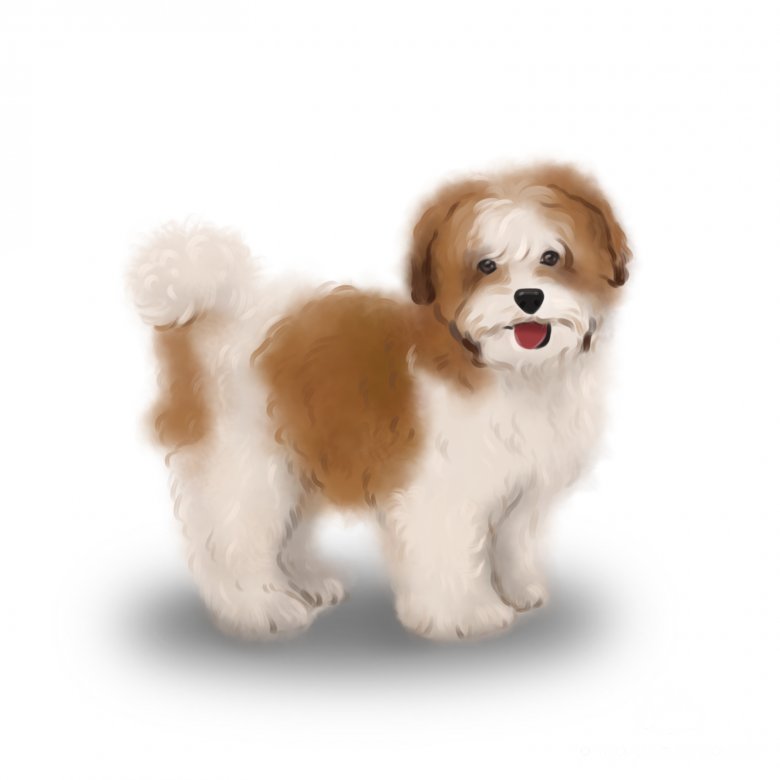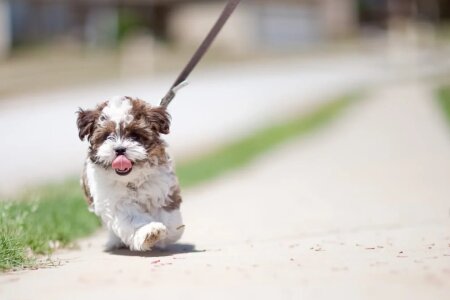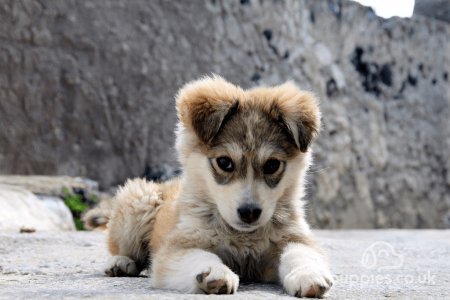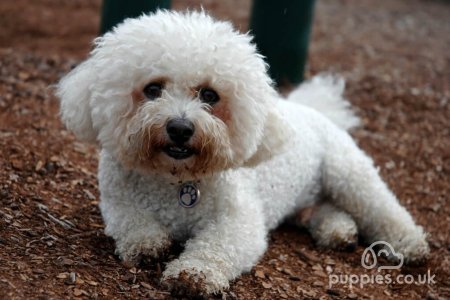Malshi (Maltese Shih Tzu, Malt-tzu, Maltzu, and Malti-zu)
Overview
One of the most popular designer dog breeds today is the cute, fluffy Malshi, a cross between two pedigree breeds, the Maltese and Shih Tzu. Malshis are small companions adaptable to just about any home and they also serve as excellent therapy dogs, too. Young or old, they’re sure to please anyone in the home.
This breed is relatively new, only having been bred since the 1990s, but it’s quickly grown to become a winner in the hearts of owners all around the world.
Physical Appearance
Maltese Shih Tzus are, as one may imagine, similar in appearance to other designer crossbreeds such as Maltipoos and Shihpoos - small, cuddly, and cute. The breed takes many of its physical attributes from its parents, the Maltese and the Shih Tzu.
Malshis have small, round eyes, ears set high on their long muzzles, and fluffy tails with significantly longer hair than elsewhere. Their stance is broad and straight, showing strength despite their cute face and small size. Part of the reason for this is their tucked bellies, which add an athletic, muscular look.
In terms of coat, Malshis can inherit a coat that resembles more a Maltese or a Shih Tzu. Generally, their coats are loose and wavy. Colours tend to be all-white with black-brown markings around the ears and on the face, but other coat colours are possible, including cream and tan markings, black, brown, black and white, brown and white, and black and brown.
How big do Malshi dogs get?
Height: 25-28 cm
Weight: 2.3-6.8 kg
Character Traits
Charming, intelligent, and abounding in affection and loyalty, the Malshi is one of the best breeds of companion pet. His temperament is perfectly suited for owners and families that can keep them company at home, who like to play, and for homes with owners that prefer a quiet, peaceful living.
Malshis are an excellent choice for first-time owners, and are considered to be hypoallergenic. Note, however, that no dog is ever truly hypoallergenic. There is always some shedding, even for breeds considered non-shedding such as the Malshi.
This breed can adapt well to any environment, including small apartments. A small balcony would be beneficial for fresh air, but a short walk outdoors or in a park will keep him happy.
Are Malshi dogs intelligent? Yes.
Are Malshi dogs affectionate? Yes, extremely.
Do Malshi dogs have high or low energy levels? High energy.
Are Malshi dogs loyal? Yes.
Are Malshi dogs playful? Yes.
Are Malshi dogs aggressive? No.
Are Malshi dogs easy to train? Yes.
Are Malshi dogs good guard dogs? No, but they can work somewhat well as watchdogs.
Ability to Socialise
As a small designer breed, Malshis suffer from ‘small dog syndrome’ which can lead to their feeling stressed out or behaving neurotically. Proper socialisation and training is therefore a must. Fortunately, training Malshis is fairly easy as they are quite intelligent and keen to learn. On the other hand, this same intelligence can lead to them learning bad behaviours just as easily.
Owners should be careful not to spoil their Malshi, especially as a puppy. One of the biggest mistakes that Malshi owners make is to treat them too much like a little baby, which in turn leads to the Malshi feeling spoilt and perhaps engaging in bad behaviour (excessive barking, chewing, fussy eating habits, and so on). Treat them like a dog and they will behave like one.
As a companion dog breed, Malshis do not naturally have a prey drive like other hunting dogs and terriers do. Nevertheless, they love to play and may chase small animals around.
Do Malshi dogs get along with other pets? Yes, somewhat.
Do Malshi dogs get along with other dogs? Yes, somewhat.
Are Malshi dogs good with kids? Yes, very well, but as puppies they may be a little boisterous.
Are Malshi dogs good with strangers? Yes, somewhat.
Lifestyle Suitability
Malshis will do well living in small apartments in urban settings as well as in large homes in rural environments. They are highly adaptable to different living conditions, but they benefit from having a little space in which to play around.
They are perhaps one of the best breeds for owners that are either retired, work from home, or have a peaceful lifestyle that don’t want a high-maintenance breed. This is exactly why Malshis were bred - to be the perfect companion pet. Moreover, the Malshi was bred to be hypoallergenic. Therefore, it is considered non-shedding (in truth, all breeds shed at least some hair).
Are Malshi dogs good for first-time owners? Yes, very much so.
Are Malshi dogs hypoallergenic? Yes.
Are Malshi dogs prone to drooling? Sometimes.
Are Malshi dogs a good breed for apartment living? Yes, they are ideal.
Do Malshi dogs shed a lot? No, hardly at all.
Do Malshi dogs bark a lot? Yes, they can be frequent barkers.
Can Malshi dogs be left alone at home? Yes, for a moderate length of time.
Can Malshi dogs handle the heat? Not too well.
Can Malshi dogs handle cold temperatures? Not too well.
Are Malshi dogs sensitive to loud noises? Yes.
General Health & Health Issues
Malshis are not the healthiest breed, suffering quite often from hereditary health conditions common to either the Maltese or the Shih Tzu breeds, or both. Nevertheless, a good diet, proper exercise, and regular checkups at the veterinarian can help ensure that they remain healthy and happy for many years to come.
Some common problems include:
Hip dysplasia: a painful condition that is caused by poor development of the hip. Can cause difficulties such as discomfort or pain or arthritis;
Breathing issues: often stemming from nostrils that are pinched too tightly or a soft palate. Malshis can suffer, as with many other small designer dogs, from respiratory issues;
Allergies: as a breed considered to be hypoallergenic to owners, it is unfortunate and perhaps ironic that Malshis themselves can develop allergies. This could be to pollen, insect bites, or from their diet. Consult your veterinarian to determine and manage the allergy symptoms;
Patellar luxation: irregular elbow bone development can lead to patellar luxation, a painful condition that can severely affect your Malshi’s ability to stand or walk properly. This can be tested for by a veterinarian as the puppy approaches six months of age.
How long do Malshi dogs live? - 12-14 years
Exercise & Play Time
One of the greatest advantages of Malshis is that they will feel just fine at home with owners that like to live a peaceful, quiet lifestyle. Their exercise needs are minimal, with only half an hour at most needed to keep them entertained and stimulated, and thus healthy.
Malshis are very playful as puppies and retain their light-hearted desire to play as they grow. As puppies, they may show signs of dominance if permitted, but this occurs largely due to owners spoiling them and failing to treat them like dogs. Try to walk your dog on a lead rather than carrying him around everywhere, and reward good behaviour with treats and positive reinforcement.
All that’s needed to keep your Malshi healthy in terms of exercise is a brisk morning walk or jog. A little playtime off-lead is also beneficial, provided it’s in a secure area such as a garden.
How much exercise does a Malshi dog need? - About 30 minutes per day
Do Malshi dogs like water play? Somewhat, just make sure they are supervised.
Nutrition & Feeding
As a small designer companion breed, Malshis don’t have a huge appetite. They should, however, be given a healthy and complete diet rich in vitamins, nutrients, and lean proteins to remain healthy, especially during developmental stages.
Obesity and weight gain are not particular issues, but as with most breeds, Malshis can be prone to overeating as adults. Keep an eye on their feeding schedule and adjust as necessary to prevent overeating.
If considering an alternative diet, such as raw food or cold-pressed dog food, please consult your local veterinarian to obtain a professional opinion.
Are Malshi dogs prone to weight gain? Not particularly.
How much should I feed a Malshi puppy? About 40-140g per day, in 3-4 sessions.
How much should I feed an adult Malshi dog? About 50-120g per day, in total.
Care & Maintenance
Malshis are fairly low-maintenance on the grooming front. Daily brushing and untangling of their long, wavy coats will keep them healthy and clean of dirt and soil.
In terms of emotional care, Malshis are quite attentive and love being around their owners and their families. It’s fairly common to have them relax on the sofa with you in the evening or to follow you into the kitchen.
- Grooming: every day, use a soft-bristled brush to go through your Malshi’s coat, removing any dead hairs and untangling any knots that pop up. Every 6-9 weeks, have him taken in for professional grooming. Inspect his ears for any signs of infection.
- Emotional care: as a breed that thrives upon social interaction, it is recommended to always have someone at home to accompany your Malshi. They can tolerate moderate periods of time alone, but this should not become habitual.
History of the Malshi
There isn’t much to say about the history of the Malshi, really. The breed is relatively new, only having been bred in the 1990s. Most likely, the original breed comes from Australia, where breeders attempted to breed the perfect companion pet that could also be hypoallergenic.
By breeding the Maltese and Shih Tzu, the Malshi retains many of the best traits of both parents without any notable downsides other than hereditary health conditions common to both parent breeds.
Since the 1990s, the popularity of Malshis has exploded. Not only were they massively popular in Australia, but they have also become popular in North America, and to a lesser extent, here in the UK as well. The breed is not recognised by the Kennel Club.
Interesting Facts About Malshi Dogs
Malshis were bred to be hypoallergenic, but in truth, no dog breed is 100% hypoallergenic as they all shed, even if only a little;
Most Malshis are bred from Maltese and Shih Tzu pedigrees, so each and every Malshi can look a little different in the litter;
Malshis most likely originated in Australia in the 1990s.
Getting a Malshi Puppy
Few breeds have risen in popularity as fast worldwide as the cute Malshi. If you are looking to purchase a Malshi puppy here in the UK, we strongly recommend you consult our buying guide first. Although a fairly common breed, many puppy mills and breeders of ill repute persist. Avoid purchasing from these and instead purchase from reputable breeders.
How much does a Malshi cost to buy? - About £300-£900 or more.
How much does a Malshi cost to feed? - An adult Malshi costs about £0.65-£1.00 per day to feed.
How much does insurance for a Malshi cost? - About £25-£45 per month.
Sensible alternatives to purchasing a new Malshi puppy include rescue and adoption.
There are few clubs and associations for this breed, but some additional information can be found here:











